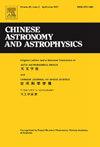Progenitor Evolution of the Double Neutron Star System J1846-0513
Q4 Physics and Astronomy
引用次数: 0
Abstract
J1846-0513 is a millisecond pulsar discovered by the Five-hundred-meter Aperture Spherical radio Telescope (FAST) which is established by China. Data analysis of observation reveals that the pulsar is harbored in a binary with orbital period of 0.613 d and eccentricity of . According to the theory of binary evolution, its eccentricity originates from an asymmetric supernova explosion during which the second neutron star was born. Together with the observed parameters of component mass, the binary is assumed to be a double neutron star system candidate. Considering its importance to understand the evolution of stars and binaries, in current work, we simulated the evolution of neutron star – helium (He) star system with initial mass of and , respectively, and initial orbital period of 0.5 day. At the end of the simulation, the total mass of the He star is reduced to with a carbon-oxygen core with mass of . A silicon core of mass and an iron/neutron-rich core of mass formed in the He star which illustrate it will end with core collapse supernova, and born a neutron star with mass of measured lower limit. Subsequent simulation of dynamical effects of the supernova explosion indicates that current model may evolve to the observed eccentric double neutron star candidate.
双中子星系统J1846-0513的祖先演化
J1846-0513是中国建立的500米口径球面射电望远镜(FAST)发现的一颗毫秒脉冲星。观测数据分析表明,该脉冲星位于双星内,轨道周期为Porb= 0.613 d,偏心率e=0.208。根据双星演化理论,它的偏心率源于一次不对称的超新星爆炸,在此期间,第二颗中子星诞生了。结合观测到的组分质量参数,假设该双星是一个候选的双中子星系统。考虑到中子星-氦(He)恒星系统对于理解恒星和双星演化的重要性,在本次工作中,我们分别模拟了初始质量为1.345M⊙和2.8M⊙,初始轨道周期为0.5 d的中子星-氦(He)恒星系统的演化。在模拟结束时,He星的总质量减少到1.556M⊙,其碳氧核心质量为1.431M⊙。氦恒星形成了一个质量为0.846M⊙的硅核和一个质量为0.086M⊙的富铁/中子核,说明它将以核坍缩超新星结束,并诞生一个质量为测量下限的中子星。随后对超新星爆炸动力学效应的模拟表明,当前模型可能演变为观测到的偏心双中子星候选者。
本文章由计算机程序翻译,如有差异,请以英文原文为准。
求助全文
约1分钟内获得全文
求助全文
来源期刊

Chinese Astronomy and Astrophysics
Physics and Astronomy-Astronomy and Astrophysics
CiteScore
0.70
自引率
0.00%
发文量
20
期刊介绍:
The vigorous growth of astronomical and astrophysical science in China led to an increase in papers on astrophysics which Acta Astronomica Sinica could no longer absorb. Translations of papers from two new journals the Chinese Journal of Space Science and Acta Astrophysica Sinica are added to the translation of Acta Astronomica Sinica to form the new journal Chinese Astronomy and Astrophysics. Chinese Astronomy and Astrophysics brings English translations of notable articles to astronomers and astrophysicists outside China.
 求助内容:
求助内容: 应助结果提醒方式:
应助结果提醒方式:


